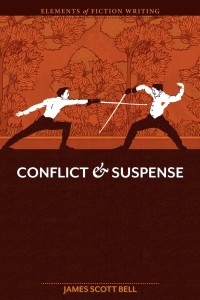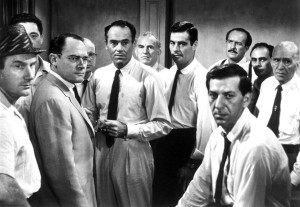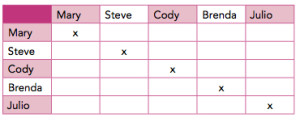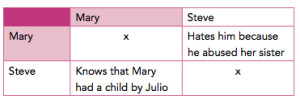by James Scott Bell
@jamesscottbell
 Imagine the first storyteller. I’ll call him Og. He was out hunting for meat. He was about to bag him some wolf when he got surprised by a mastodon lumbering by.
Imagine the first storyteller. I’ll call him Og. He was out hunting for meat. He was about to bag him some wolf when he got surprised by a mastodon lumbering by.
Bummer.
He dropped his club and ran. He hid in some rocks. An hour or so later he came back to his prey and found it being devoured by a saber toothed tiger.
Double bummer.
Then Og had to trek back to the waiting fire. His tribe was sitting there awaiting some steaks (they were tired of berries and roots.) They looked at Og and grunted something which can be roughly translated, “Where’s the meat, man?”
Og was on the spot. His position as chief hunter-gatherer was up for grabs, depending on what he said next.
The last time something like this happened, and the tribe asked what went wrong, Og merely shrugged and threw dirt at them. This didn’t help matters at all. They seemed unwilling to give Og more chances.
So now Og gets on his haunches and says, “I was out hunting like always, and had a wolf in my sights. I threw a rock and got him right on the head. He went down. I was about to go get him when I heard this ROAARRRR!”
He pauses to take stock of the reactions around the fire. Every face is turned toward him. He can see consuming interest in their eyes.
He has them hooked.
Good, Og thinks. Let’s see if I can keep them that way while I figure out how to get out of this.
“I spin around,” Og says, “and there is a tiger with those long, spiked teeth. There is spit dripping off those teeth. His eyes were huge, as big as lakes! I could smell his fur. It smelled like death.”
The audience is leaning forward now. Og thinks, That went well. If I take time to describe things this way, it stretches out the story and the tension. And that bit about the smell, that was pure genius.
Og is beginning to develop a style.
He’s also searching for an ending, and so he lays out, beat by beat, a story of this encounter with the tiger and the ensuing fight to save his own life. He finally gets to the end and speaks of a mighty battle with the beast, until his ultimate triumph.
Someone in the audience asks, “So where’s the tiger?”
Og must think up a twist ending. So he comes up with the speculative fiction genre, and says the god of the mountains came down and took the tiger as tribute. He was about to call down fire from the sky on Og’s tribe. Og told him not to, that it would be bad, and he would fight the god if he had to. The god relented.
So Og has saved all their lives. Or so the story goes.
Well, the reaction of the listeners is so good that Og gets a double portion of berries. An attractive woman gives him a blanket of squirrel fur in honor of his exploits. One of the old men gives Og his best club. A couple of the younger tribe members hand over their favorite trinkets, and promise more if Og will tell more stories.
And Og thinks, Maybe I can make a living at this.
Og’s brother, who collects the booty, keeps 15% of it.
Og had more thrillers on his tongue.
Later, Og began to tell stories that were about his emotions. How he was having to deal with past demons, like his father flicking pebbles at him when he was a boy, and when he fell in love with a cave girl who later got stepped on by a wooly mammoth. Og starts calling these “character driven” stories, but knows they are based on the same idea: a high stakes threat to the character’s life and happiness.
And you know what? The essence of story has not changed—from Og to the early myths to the Greek drama to Shakespeare; from Jane Austen to Herman Melville to Mark Twain; from Dashiell Hammett to Raymond Chandler to Sue Grafton.
It’s all about trouble.
Trouble comes on a continuum, from the annoying to the life-threatening. When you can’t find your reading glasses that’s one kind of trouble. A kidnapped child is quite another.
Every scene in your book should have some form of trouble that produces emotions that are also on a continuum, from low-level worry to outright terror.
That’s your palette, writer. Dip into it each day as your write your story. Always be thinking How can I make more trouble? How can I make it worse?
Then stick the landing. Nail the ending. And readers will line up to give you a double portion of berries.
Are you making enough trouble? Do your openings disturb? Do you write “friend talking to friend” scenes that need more tension (watch out for eating scenes)? What are some of your favorite ways to make trouble (a la “bring in a guy with a gun”)?
Note: The link in the post takes you to an Og-inspired thriller that is on Kindle-sale for 99¢ this week. The book is Your Son is Alive.

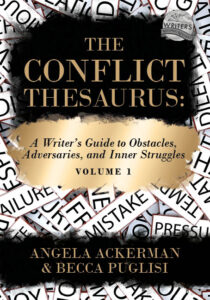
 Becca Puglisi is an international speaker, writing coach, and bestselling author of The Emotion Thesaurus and other resources for writers.
Becca Puglisi is an international speaker, writing coach, and bestselling author of The Emotion Thesaurus and other resources for writers.
